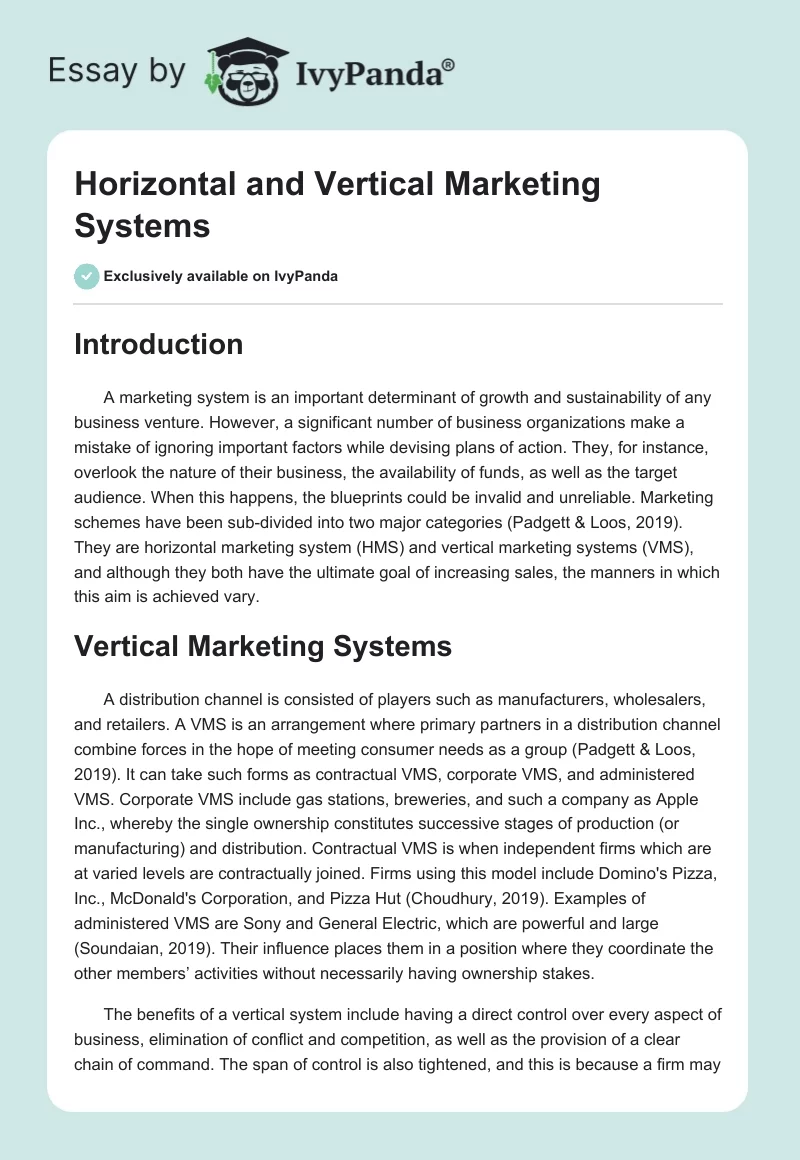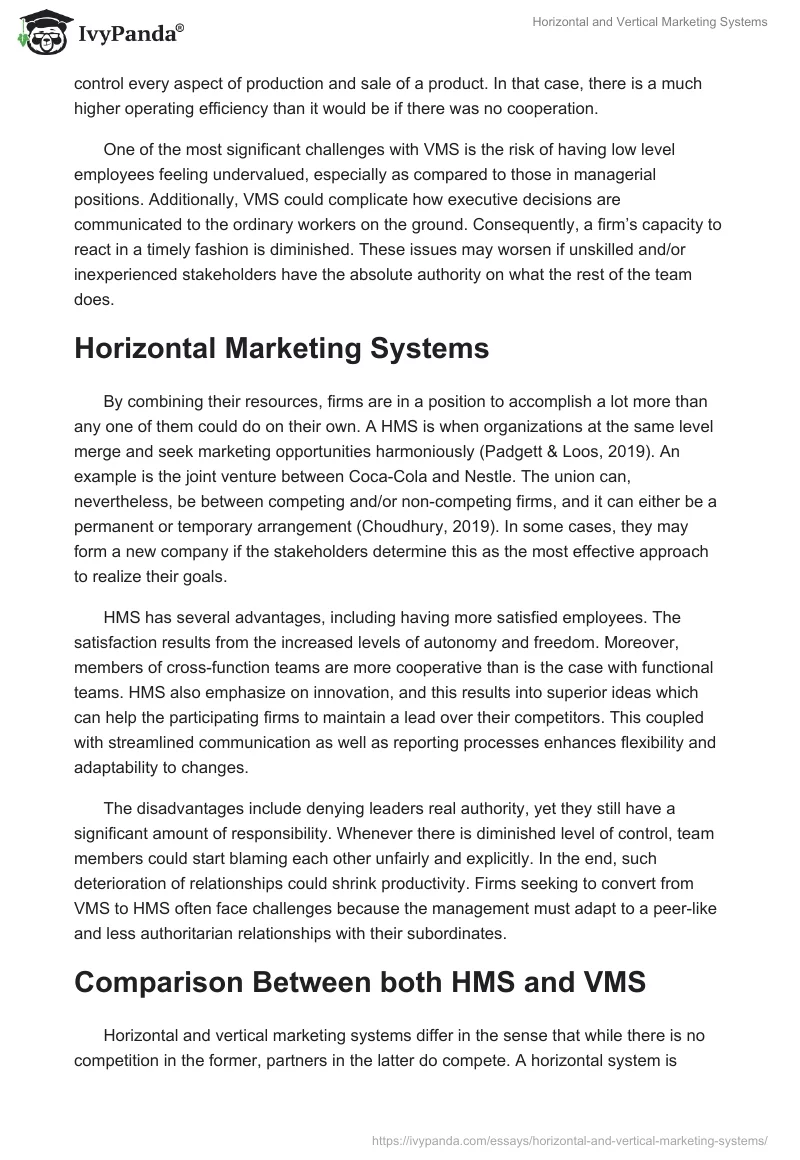Introduction
A marketing system is an important determinant of growth and sustainability of any business venture. However, a significant number of business organizations make a mistake of ignoring important factors while devising plans of action. They, for instance, overlook the nature of their business, the availability of funds, as well as the target audience. When this happens, the blueprints could be invalid and unreliable. Marketing schemes have been sub-divided into two major categories (Padgett & Loos, 2019). They are horizontal marketing system (HMS) and vertical marketing systems (VMS), and although they both have the ultimate goal of increasing sales, the manners in which this aim is achieved vary.
Vertical Marketing Systems
A distribution channel is consisted of players such as manufacturers, wholesalers, and retailers. A VMS is an arrangement where primary partners in a distribution channel combine forces in the hope of meeting consumer needs as a group (Padgett & Loos, 2019). It can take such forms as contractual VMS, corporate VMS, and administered VMS. Corporate VMS include gas stations, breweries, and such a company as Apple Inc., whereby the single ownership constitutes successive stages of production (or manufacturing) and distribution. Contractual VMS is when independent firms which are at varied levels are contractually joined. Firms using this model include Domino’s Pizza, Inc., McDonald’s Corporation, and Pizza Hut (Choudhury, 2019). Examples of administered VMS are Sony and General Electric, which are powerful and large (Soundaian, 2019). Their influence places them in a position where they coordinate the other members’ activities without necessarily having ownership stakes.
The benefits of a vertical system include having a direct control over every aspect of business, elimination of conflict and competition, as well as the provision of a clear chain of command. The span of control is also tightened, and this is because a firm may control every aspect of production and sale of a product. In that case, there is a much higher operating efficiency than it would be if there was no cooperation.
One of the most significant challenges with VMS is the risk of having low level employees feeling undervalued, especially as compared to those in managerial positions. Additionally, VMS could complicate how executive decisions are communicated to the ordinary workers on the ground. Consequently, a firm’s capacity to react in a timely fashion is diminished. These issues may worsen if unskilled and/or inexperienced stakeholders have the absolute authority on what the rest of the team does.
Horizontal Marketing Systems
By combining their resources, firms are in a position to accomplish a lot more than any one of them could do on their own. A HMS is when organizations at the same level merge and seek marketing opportunities harmoniously (Padgett & Loos, 2019). An example is the joint venture between Coca-Cola and Nestle. The union can, nevertheless, be between competing and/or non-competing firms, and it can either be a permanent or temporary arrangement (Choudhury, 2019). In some cases, they may form a new company if the stakeholders determine this as the most effective approach to realize their goals.
HMS has several advantages, including having more satisfied employees. The satisfaction results from the increased levels of autonomy and freedom. Moreover, members of cross-function teams are more cooperative than is the case with functional teams. HMS also emphasize on innovation, and this results into superior ideas which can help the participating firms to maintain a lead over their competitors. This coupled with streamlined communication as well as reporting processes enhances flexibility and adaptability to changes.
The disadvantages include denying leaders real authority, yet they still have a significant amount of responsibility. Whenever there is diminished level of control, team members could start blaming each other unfairly and explicitly. In the end, such deterioration of relationships could shrink productivity. Firms seeking to convert from VMS to HMS often face challenges because the management must adapt to a peer-like and less authoritarian relationships with their subordinates.
Comparison Between both HMS and VMS
Horizontal and vertical marketing systems differ in the sense that while there is no competition in the former, partners in the latter do compete. A horizontal system is focused on a large audience, but the vertical system tends to emphasize on a small audience. The vertical system is appropriate when the firms in question operate within the same industry. In such a case, three levels of stakeholders are involved, and they are retailer, wholesaler, and manufacture. The decisions and activities of any one of them matter to the other two (Soundaian, 2019). Indeed, what a player chooses to do affects the profits earned by the partnering organizations.
As shown in Table 1 below, a horizontal marketing system is reflected where the different organizations pulling resources together are at the same level of operation. These could be manufacturers, distributors, wholesalers, or even retailers (Padgett & Loos, 2019). They cooperate in an endeavor to maximize the amount of profits earned. This is notably different from what firms in the vertical systems do, which is to compete among one another. It is noteworthy that a horizontal system is focused on a much bigger audience than is the case with a vertical system. To satisfy the needs of a sizeable audience, firms involved combine capital, marketing resources, and production capacities in a bid to optimize their potential.
Table 1: The Comparison between HMS and VMS.
Conclusion
A HMS is where the partnering organizations are at the same stage of production. A vertical marketing system includes organizations at various stages of production. With the former, therefore, every member is involved in the manufacturing of the end product. Under VMS, a member specializes and hence optimizes its scope in a single branch of production. Members of a VMS get used to routines, and are often answer to a controlling body. On the other hand, HMS is where members are free to conduct their internal affairs as they choose, and this is because they are left independent and autonomous. It is upon the organization to select the most appropriate model based on its nature, available sources, and the target audience.
References
Choudhury, R. G. (2019). Sales and distribution management for organizational growth. Hershey, PA: IGI Global.
Padgett, D., & Loos, A. (2019). Applied marketing: Connecting classrooms to careers. Hoboken, New Jersey: John Wiley & Sons.
Soundaian, S. (2019). Strategic marketing management. Chennai, India: MJP Publisher.


